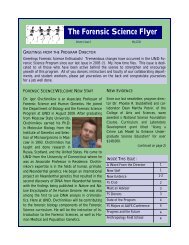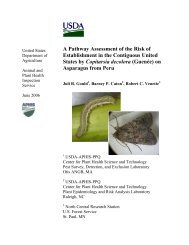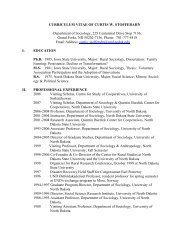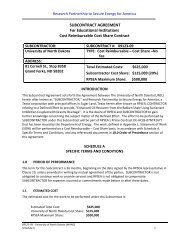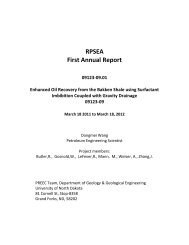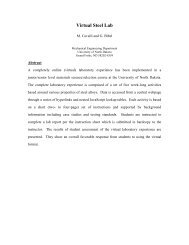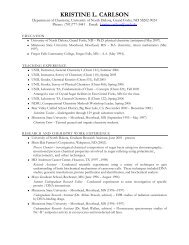Dirigent proteins in conifer defense: gene discovery, phylogeny, and ...
Dirigent proteins in conifer defense: gene discovery, phylogeny, and ...
Dirigent proteins in conifer defense: gene discovery, phylogeny, and ...
Create successful ePaper yourself
Turn your PDF publications into a flip-book with our unique Google optimized e-Paper software.
32<br />
(PDIR17) to 192 (PDIR19) am<strong>in</strong>o acids. Among<br />
the entire DIR-b subfamily, ORFs range from 125<br />
am<strong>in</strong>o acids for AtDIR22 to 192 am<strong>in</strong>o acids for<br />
PDIR9 <strong>and</strong> SbDIR1. There is no <strong>in</strong>formation <strong>in</strong><br />
the literature concern<strong>in</strong>g expression patterns or<br />
proposed functions for any DIR-like <strong>gene</strong>s <strong>in</strong><br />
subfamily DIR-b, <strong>and</strong> this group, along with<br />
DIR-c, DIR-d <strong>and</strong> DIR-e, has not previously been<br />
recognized <strong>in</strong> the literature, although all four<br />
subfamilies are clearly related to the DIR-a family<br />
(Kim et al., 2002).<br />
No <strong>conifer</strong> <strong>gene</strong>s have been identified <strong>in</strong> subfamilies<br />
DIR-c, DIR-d, <strong>and</strong> DIR-e, which are<br />
therefore described only briefly <strong>and</strong> for completeness<br />
of this analysis. Subfamily DIR-c consists<br />
exclusively of angiosperm monocot DIR-like <strong>gene</strong>s<br />
<strong>in</strong>clud<strong>in</strong>g three representatives from sugarcane<br />
(Saccharum offic<strong>in</strong>arum), <strong>and</strong> seven members from<br />
wheat, barley, <strong>and</strong> corn (Figure 2). ORFs range<br />
from 187 (SoDIR1, 2, <strong>and</strong> 3) to 345 (TaDIR2)<br />
am<strong>in</strong>o acids. With<strong>in</strong> subfamily DIR-c am<strong>in</strong>o acid<br />
identity is extremely divergent, rang<strong>in</strong>g from 9.6%<br />
to 97.4% across the entire length of each prote<strong>in</strong>,<br />
with very limited conservation with<strong>in</strong> the N-<br />
term<strong>in</strong>al half of <strong>prote<strong>in</strong>s</strong>. With<strong>in</strong> the conserved<br />
part of the prote<strong>in</strong> sequence, identity ranges from<br />
19.3% to 100%. The seven DIR-like <strong>gene</strong>s from<br />
wheat, barley, <strong>and</strong> corn possess a unique 140<br />
am<strong>in</strong>o acid extension at their C-term<strong>in</strong>us with high<br />
similarity to the jacal<strong>in</strong>-like doma<strong>in</strong> common to<br />
lect<strong>in</strong> <strong>prote<strong>in</strong>s</strong> (Sankaranarayanan et al., 1996),<br />
with a proposed role <strong>in</strong> <strong>defense</strong> aga<strong>in</strong>st <strong>in</strong>sects<br />
(Blanchard et al., 2001). Subfamily DIR-d consists<br />
of seven angiosperm <strong>gene</strong>s from Arabidopsis, rice,<br />
<strong>and</strong> cotton (Gossypium barbadense) with am<strong>in</strong>o<br />
acid identities rang<strong>in</strong>g from 12.0% to 77.5% when<br />
the entire <strong>prote<strong>in</strong>s</strong> are considered, <strong>and</strong> 17.1% to<br />
78.1% when only the conserved part of each<br />
prote<strong>in</strong> is considered. ORFs range <strong>in</strong> size from 185<br />
(AtDIR2) to 229 (OsDIR1) am<strong>in</strong>o acids. Subfamily<br />
DIR-e consists of only five Arabidopsis DIRlike<br />
<strong>gene</strong>s, with am<strong>in</strong>o acid identities rang<strong>in</strong>g from<br />
3.8% to 94.3% across the entire length of each<br />
prote<strong>in</strong>, <strong>and</strong> from 33.3% to 98.1% when only the<br />
conserved region is considered. ORFs range from<br />
243 (AtDIR16) to 447 (AtDIR10) am<strong>in</strong>o acids,<br />
which is considerably longer than DIR or DIRlike<br />
<strong>prote<strong>in</strong>s</strong> from the other four subfamilies. In<br />
particular, AtDIR10 is the largest DIR or DIRlike<br />
prote<strong>in</strong> discovered to date, possess<strong>in</strong>g 150–<br />
200 additional am<strong>in</strong>o acids at the N-term<strong>in</strong>us that<br />
has similarity to other plant glyc<strong>in</strong>e-rich <strong>prote<strong>in</strong>s</strong>,<br />
as well as weak similarity to jacal<strong>in</strong>-like doma<strong>in</strong>s<br />
from other Arabidopsis <strong>prote<strong>in</strong>s</strong>.<br />
Expression profiles of DIR <strong>and</strong> DIR-like <strong>gene</strong>s<br />
<strong>in</strong> Sitka spruce <strong>in</strong> response to mechanical wound<strong>in</strong>g<br />
<strong>and</strong> weevil attack detected by real-time PCR<br />
To validate our <strong>in</strong>itial observations of differential<br />
wound- <strong>and</strong> <strong>in</strong>sect-<strong>in</strong>duced <strong>gene</strong> expression from<br />
the cDNA microarray studies (Table 1), we<br />
applied quantitative real-time PCR to exam<strong>in</strong>e<br />
<strong>gene</strong>-specific transcript levels of five DIR-a <strong>and</strong><br />
three DIR-like <strong>gene</strong>s <strong>in</strong> Sitka spruce bark <strong>and</strong><br />
xylem tissue subjected to mechanical wound<strong>in</strong>g or<br />
weevil feed<strong>in</strong>g. The data are presented as transcript<br />
abundance normalized to b-act<strong>in</strong> levels<br />
(Figure 3) <strong>and</strong> as fold-<strong>in</strong>duction relative to untreated<br />
control tissues (Table 4). Gene-specific<br />
primers were designed based on full-length cDNA<br />
sequences. Gene expression analysis for members<br />
of the DIR-a group <strong>in</strong>cluded PDIR2, PDIR5,<br />
PDIR6, PDIR8 <strong>and</strong> PDIR13. Among members of<br />
the DIR-b subfamily, we analyzed transcript levels<br />
for PDIR1, PDIR10, <strong>and</strong> PDIR12. In <strong>gene</strong>ral,<br />
results from real-time PCR analysis were <strong>in</strong> good<br />
agreement with the overall observations of microarray<br />
analyses. We found rapidly <strong>in</strong>creased transcript<br />
levels (fold change >2) of the DIR-a<br />
subfamily <strong>gene</strong>s PDIR6, PDIR8 <strong>and</strong> PDIR13 <strong>in</strong><br />
bark tissue 2 h after the <strong>in</strong>itiation of weevil feed<strong>in</strong>g<br />
or after mechanical wound<strong>in</strong>g. Peak <strong>in</strong>duction for<br />
these <strong>gene</strong>s <strong>in</strong> bark tissue occurred post mechanical<br />
wound<strong>in</strong>g at 6 h for PDIR8 (92.2-fold), <strong>and</strong><br />
48 h for PDIR6 (21.8-fold) <strong>and</strong> PDIR13 (115.6-<br />
fold). Similar to our microarray results, <strong>in</strong>duction<br />
by weevil feed<strong>in</strong>g was less rapid <strong>and</strong> of lower<br />
magnitude when measured by real-time PCR, with<br />
peak <strong>in</strong>duction at 48 h for PDIR8 (28.1-fold),<br />
PDIR6 (9.1-fold) <strong>and</strong> PDIR13 (27.1-fold). It is<br />
important to note, that damage caused by stembor<strong>in</strong>g<br />
weevils is a relatively slow <strong>and</strong> cont<strong>in</strong>uous<br />
process compared to the one-time, rapid mechanical<br />
wound treatment. Among other DIR-a subfamily<br />
<strong>gene</strong>s exam<strong>in</strong>ed, PDIR2 was also <strong>in</strong>duced,<br />
but with a slower <strong>in</strong>itial response that peaked at<br />
48 h after mechanical wound<strong>in</strong>g (53.3-fold) <strong>and</strong><br />
weevil feed<strong>in</strong>g (46.9-fold). PDIR5 was only<br />
moderately <strong>in</strong>duced 48 h post-treatment with<br />
maximum responses of 14.4-fold (mechanical<br />
wound<strong>in</strong>g) <strong>and</strong> 3.7-fold (weevil feed<strong>in</strong>g). Addi-






